1988 PONTIAC FIERO check engine
[x] Cancel search: check enginePage 678 of 1825
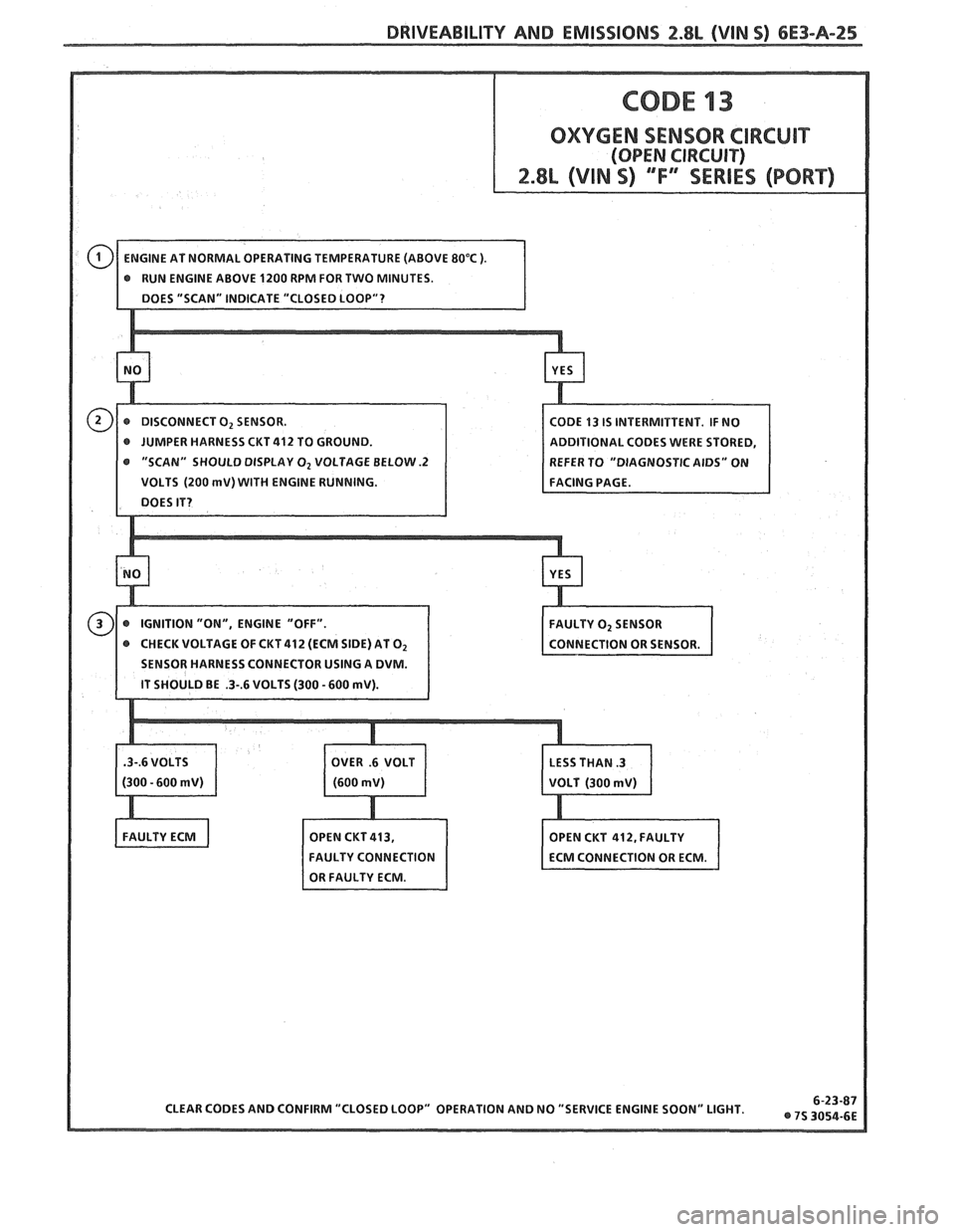
DRIVEABILITY AND EMISSIONS 2.8L (VIN 5) 6E3-A-25
OXYGEN SENSOR CIRCUIT
ODE 13 IS INTERMITTENT. IF NO
@ JUMPER HARNESS CKT 412 TO GROUND. DDlTlONAL CODES WERE STORED,
"SCAN" SHOULD DISPLAY
O2 VOLTAGE BELOW .2
VOLTS (200 mV) WITH ENGINE RUNNING.
CHECK VOLTAGE OF CKT
412 (ECM SIDE) AT O2
SENSOR HARNESS CONNECTOR USING A DVM.
Page 679 of 1825
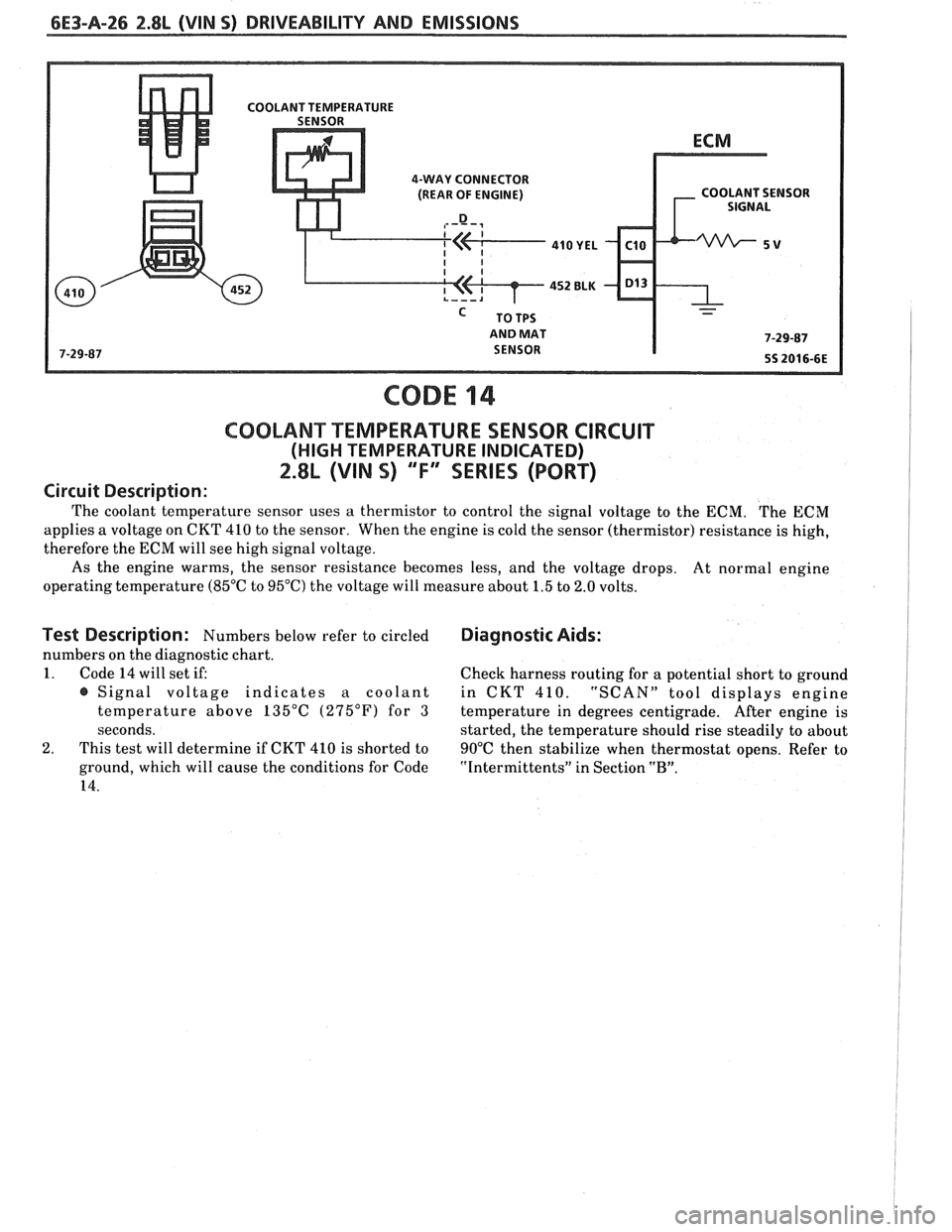
6E3-A-26 2.8L (VIN 5) DRIVEABILITY AND EMISSIONS
4-WAY CONNECTOR
(REAR OF ENGINE) COOLANT SENSOR
AND MAT
CODE 14
COOLANT TEMPERATURE SENSOR CIRCUIT
(HIGH TEMPERATURE INDICATED)
2.8L (VIN S) ""F-SERIES (PORT)
Circuit Description:
The coolant temperature sensor uses a thermistor to control the signal voltage to the ECM. The ECM
applies a voltage on CKT 410 to the sensor. When the engine is cold the sensor (thermistor) resistance is high,
therefore the ECM will see high signal voltage.
As the engine warms, the sensor resistance becomes less, and the voltage drops.
At normal engine
operating temperature (85°C to 95°C) the voltage will measure about 1.5 to 2.0 volts.
Test Description: Numbers below refer to circled Diagnostic Aids:
numbers on the diagnostic chart.
1. Code 14 will set if:
Check harness routing for a potential short to ground
@ Signal voltage indicates a coolant in CKT 410. "SCAN" tool displays engine
temperature above 135°C (275°F) for
3 temperature in degrees centigrade. After engine is
seconds. started, the temperature should rise steadily to about
2. This test will determine if CKT 410 is shorted to
90°C then stabilize when thermostat opens. Refer to
ground, which will cause the conditions for Code
"Intermittents" in Section "B".
14.
Page 681 of 1825
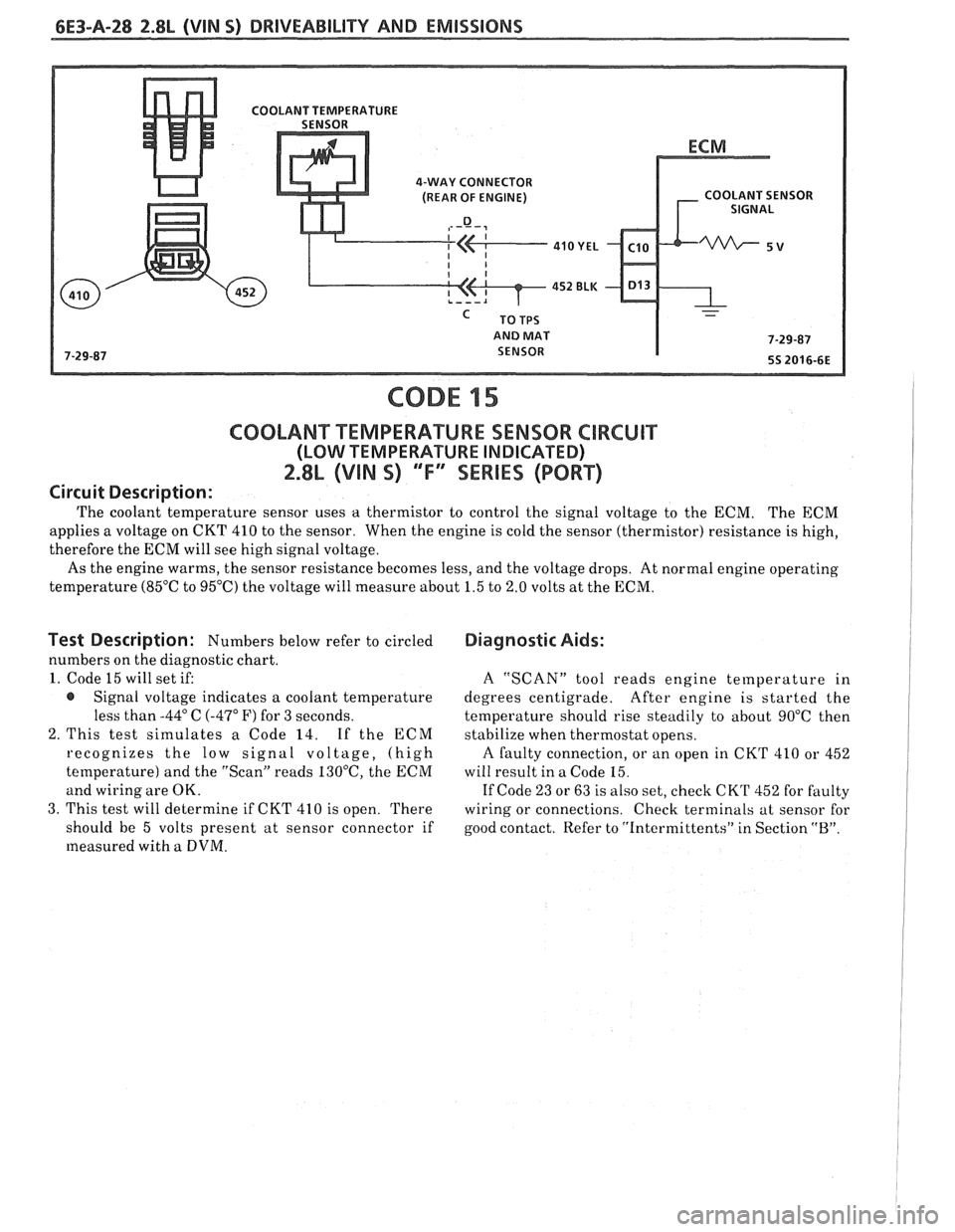
6E3-A-28 2.8L (VIN S) DRIVEABILITY AND EMISSIONS
4-WAY CONNECTOR
(REAR OF ENGINE) COOLANT SENSOR
AND MAT
CODE 15
C0OLAN"FT"EMPERAWURE SENSOR CIRCUIT
(LOW TEMPERATURE INDICATED)
2.8L (VIN S) 'Tf3SEWlES (PORT)
Circuit Description:
The coolant temperature sensor uses a thermistor to control the signal voltage to the ECM. The ECM
applies a voltage on CKT 410 to the sensor. When the engine is cold the sensor (thermistor) resistance is high,
therefore the ECM will see high signal voltage.
As the engine warms, the sensor resistance becomes less, and the voltage drops. At normal engine operating
temperature
(85OC to 95°C) the voltage will measure about 1.5 to 2.0 volts at the ECM.
Test Description : Numbers below refer to circled
numbers on the diagnostic chart.
1. Code 15 will set if:
@ Signal voltage indicates a coolant temperature
less than
-44" C (-47" F) for 3 seconds.
2. This test simulates a Code 14. If the
ECM
recognizes the low signal voltage, (high
temperature) and the "Scan" reads
130°C, the ECM
and wiring are OK.
3. This test will determine if CKT 410 is open. There
should be 5 volts present at sensor connector if
measured with
a DVM.
Diagnostic Aids:
A "SCAN" tool reads engine temperature in
degrees centigrade. After engine is started the
temperature should rise steadily to about 90°C then
stabilize when thermostat opens.
A faulty connection, or an open in CKT 410 or 452
will result in a Code
15.
If Code 23 or 63 is also set, check CK'I' 452 for faulty
wiring or connections. Check terminals at sensor for
good contact. Refer to "intermittents" in Section
"B".
Page 683 of 1825
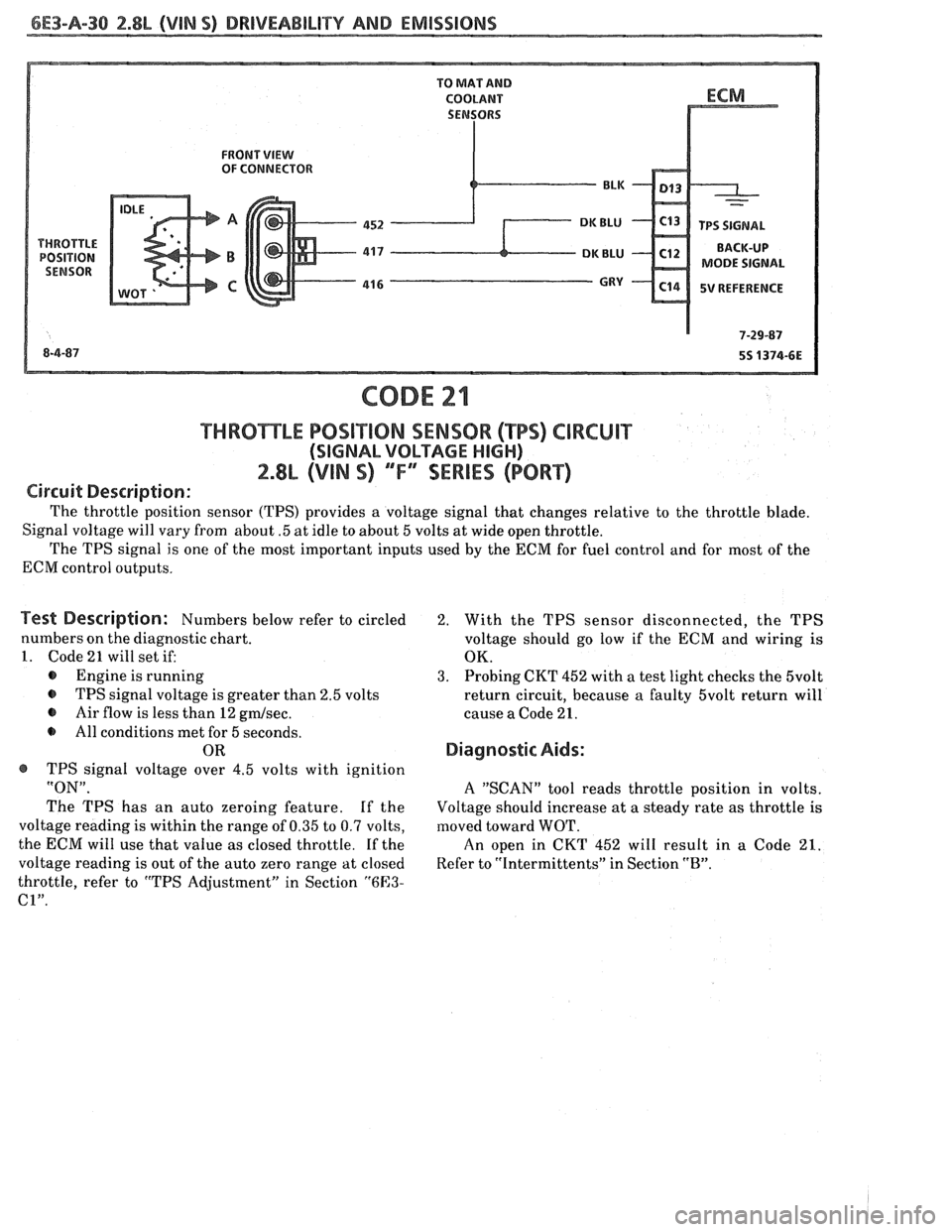
6E3-A-38 2.8b (VIM S) DRIVEABILITY AND EMISSIONS
FRONT VIEW OF CONNECTOR
MODE SIGNAL
5V REFERENCE
THRBmLE POSiT10N SENSOR (TPS) CIRCUIT
(SIGNAL VOLTAGE HIGH)
2.8L (VIN S) ""F-SERIES (PORT)
Circuit Description:
The throttle position sensor (TPS) provides a voltage signal that changes relative to the throttle blade.
Signal voltage will vary from about
.5 at idle to about 5 volts at wide open throttle.
The TPS signal is one of the most important inputs used by the ECM for fuel control and for most of the
ECM control outputs.
Test Description: Numbers below refer to circled
numbers on the diagnostic chart.
1. Code 21 will set if:
@ Engine is running
@ TPS signal voltage is greater than 2.5 volts
@ Air flow is less than 12 gmlsec.
All conditions met for 5 seconds.
OR
@ TPS signal voltage over 4.5 volts with ignition
"ON".
The TPS has an auto zeroing feature. If the
voltage reading is within the range of 0.35 to 0.7 volts,
the ECM will use that value as closed throttle.
If the
voltage reading is out of the auto zero range at closed
throttle, refer to "TPS Adjustment" in Section
"6E3-
C1".
2. With the TPS sensor disconnected, the TPS
voltage should go low if the
ECM and wiring is
OK.
3. Probing CKT 452 with a test light checks the 5volt
return circuit, because a faulty 5volt return will
cause a Code 21.
Diagnostic Aids:
A "SCAN" tool reads throttle position in volts.
Voltage should increase at a steady rate as throttle
is
moved toward WOT.
An open in CKT 452 will result in a Code 21.
Refer to "Intermittents" in Section "B".
Page 685 of 1825
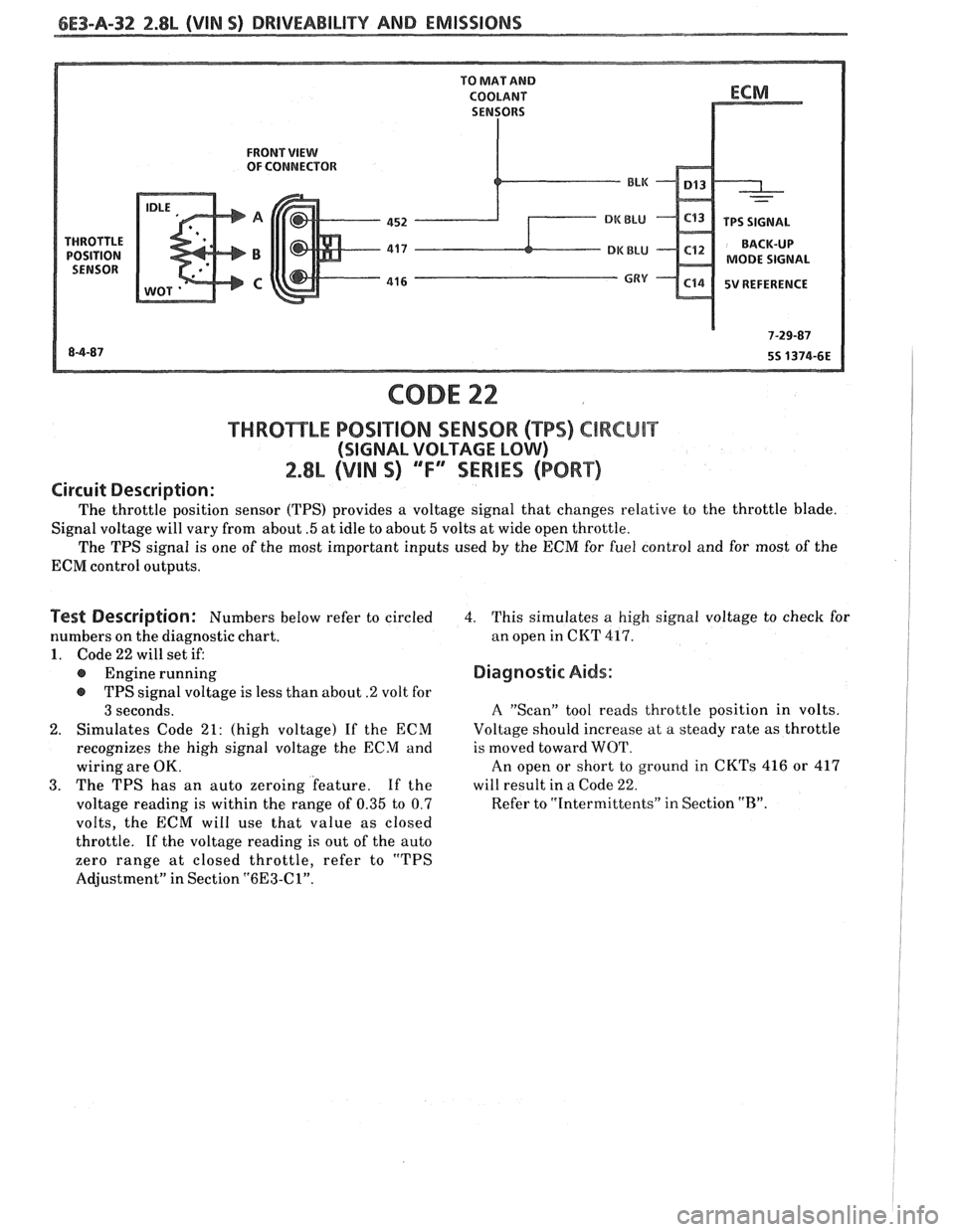
6E3-A-32 2.8L (VIN S) DRIVEABILITY AND EMISSIONS
FRONT VIEW OF CONNECTOR
MODE SIGNAL
5V REFERENCE
CODE 22
f HRO"I$E"LE POSlTlON SENSOR ("BPS) ClRCUlT
(SIGNAL VOLTAGE LOW)
2.8L (VIN 9) "F" "SERIES (PORT)
Circuit Description:
The throttle position sensor (TPS) provides a voltage signal that changes relative to the throttle blade.
Signal voltage will vary from about
.5 at idle to about 5 volts at wide open throttle.
The TPS signal is one of the most important inputs used
by the ECM for fuel control and for most of the
ECM control outputs.
Test Description: Numbers below refer to circled
numbers on the diagnostic chart.
1. Code 22 will set if:
@ Engine running
@ TPS signal voltage is less than about .2 volt for
3 seconds.
2. Simulates Code 21: (high voltage) If the ECM
recognizes the high signal voltage the ECM and
wiring are OK.
3. The TPS has an auto zeroing feature. If the
voltage reading is within the range of
0.35 to 0.7
volts, the ECM will use that value as closed
throttle.
If the voltage reading is out of the auto
zero range at closed throttle, refer to "TPS
Adjustment" in Section
"6E3-Cl".
4. This simulates a high signal voltage to check for
an open in CKT
417.
Diagnostic Aids:
A "Scan" tool reads throttle position in volts.
Voltage should increase at a steady rate as throttle
is moved toward WOT.
An open or short to ground in CKTs 416 or 417
will result in a Code
22.
Refer to "Intermittents" in Section "B".
Page 689 of 1825
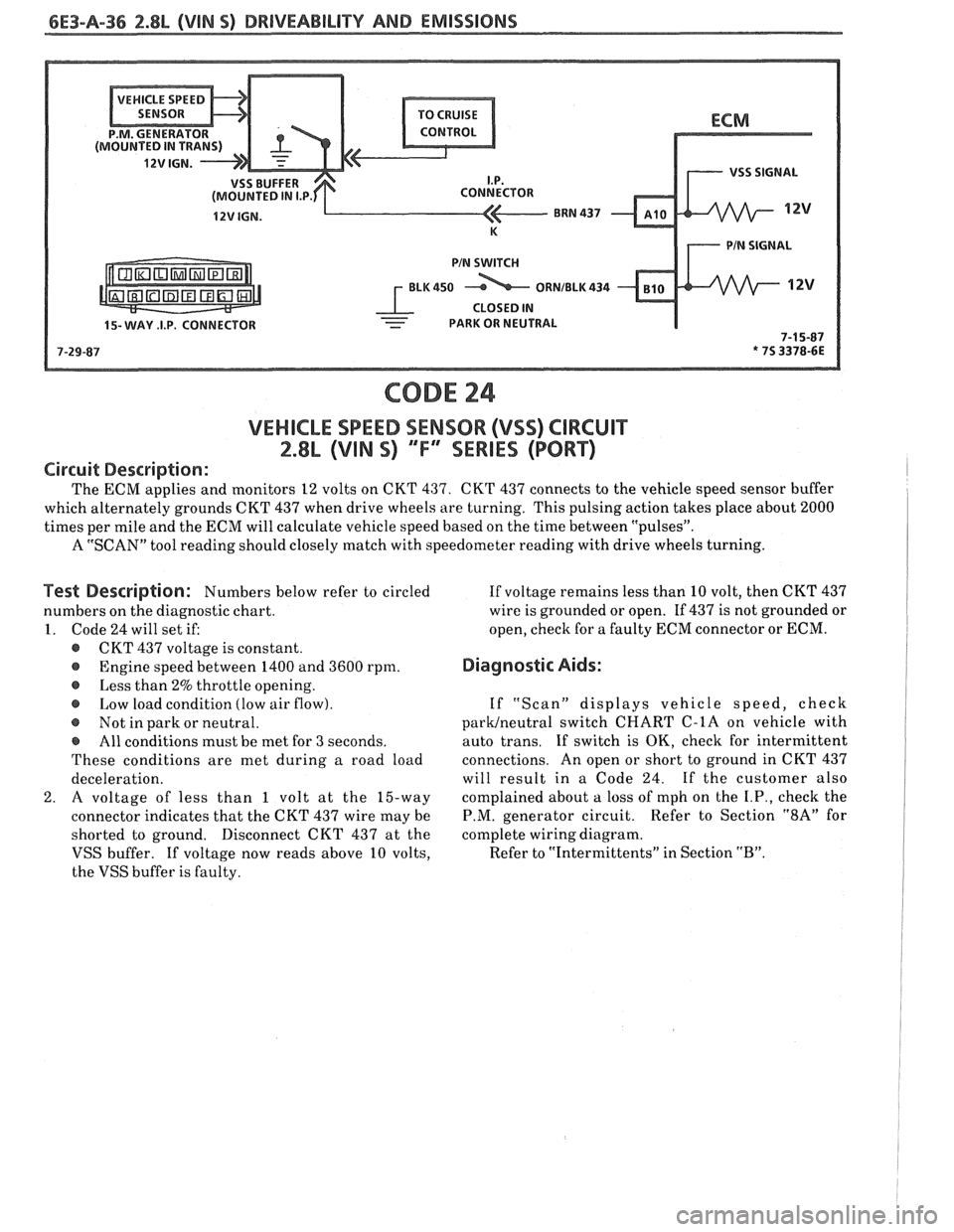
6E3-A-36 2.8L (VlN 5) DRIVEABILIW YW EMISSIONS
- PARK OR NEUTRAL
CODE 24
VEHICLE SPEED SENSOR (VSS) CIRCUIT
2.8L (VIN 5) ""FYMIES (PORT)
Circuit Description:
The ECM applies and monitors 12 volts on CKT 437. CKT 437 connects to the vehicle speed sensor buffer
which alternately grounds CKT
437 when drive wheels are turning. This pulsing action takes place about 2000
times per mile and the ECM will calculate vehicle speed based on the time between "pulses".
A "SCAN" tool reading should closely match with speedometer reading with drive wheels turning.
Test Description: Numbers below refer to circled
numbers on the diagnostic chart.
1. Code
24 will set if:
@ CKT 437 voltage is constant.
@ Engine speed between 1400 and 3600 rpm.
o Less than 2% throttle opening.
Low load condition (low air flow).
@ Not in park or neutral.
e All conditions must be met for 3 seconds.
These conditions are met during a road load
deceleration.
2. A voltage of less than 1 volt at the 15-way
connector indicates that the CKT
437 wire may be
shorted to ground. Disconnect CKT
437 at the
VSS buffer.
If voltage now reads above 10 volts,
the VSS buffer is faulty. If
voltage remains less than
10 volt, then CKT 437
wire is grounded or open. If 437 is not grounded or
open,
check for a faulty ECM connector or ECM.
Diagnostic Aids:
If "Scan" displays vehicle speed, check
paruneutral switch CHART C-1A on vehicle with
auto trans.
If switch is OK, check for intermittent
connections. An open or short to ground in CKT
437
will result in a Code 24. If the customer also
complained about
a loss of mph on the I.P., check the
P.M. generator circuit. Refer to Section "8A" for
complete wiring diagram.
Refer to "Intermittents" in Section
"B".
Page 693 of 1825
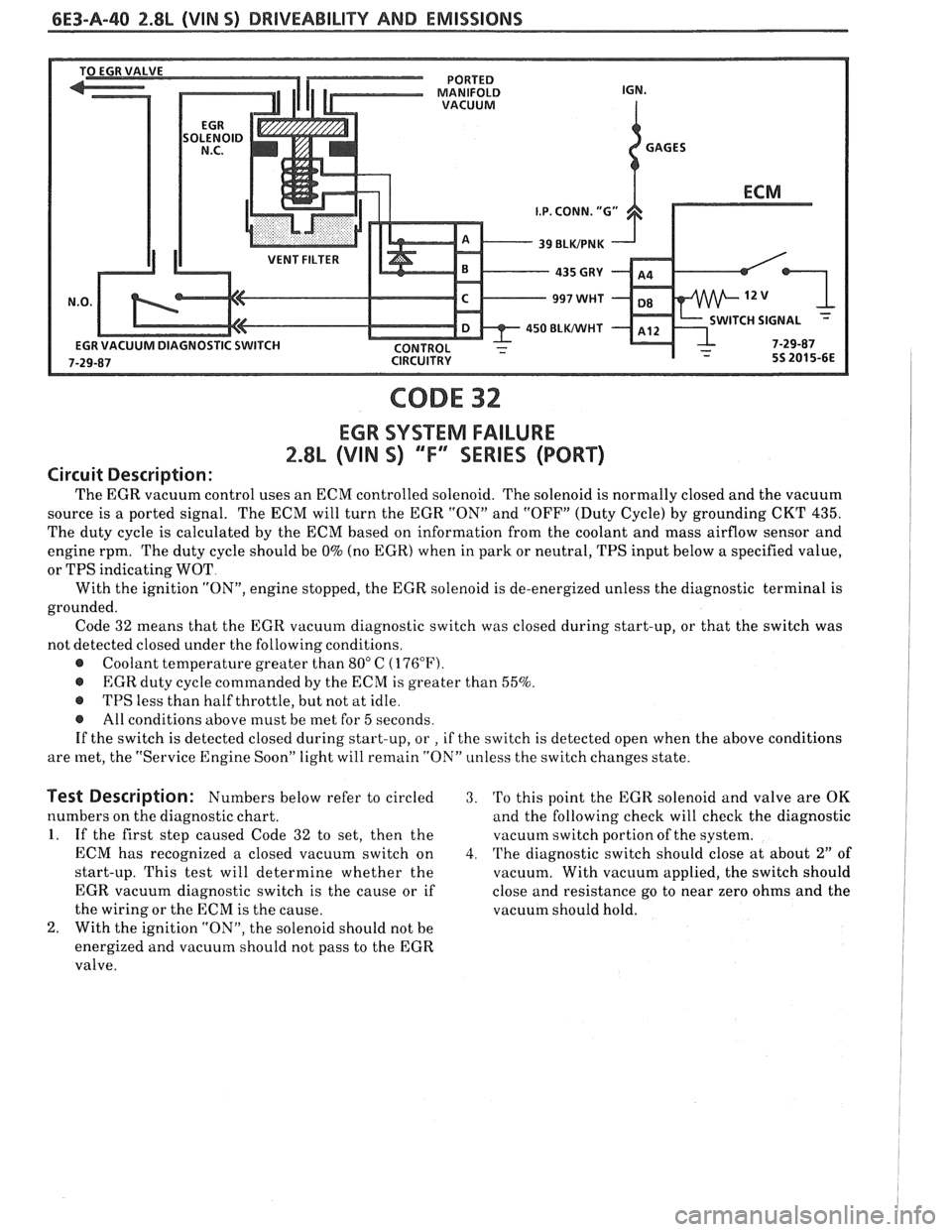
6E3-A-40 2.8L (VIN 5) DRIVEABILITY AND EMISSIONS
VENT FILTER
450 BLWHT ITCH SIGNAL -
CODE 32
EGR SYSTEM FAILURE
2.8L (VIN S) "F" "SERIES (PORT)
Circuit Description:
The EGR vacuum control uses an ECM controlled solenoid. The solenoid is normally closed and the vacuum
source is a ported signal. The ECM will turn the EGR "ON" and "OFF" (Duty Cycle) by grounding CKT
435.
The duty cycle is calculated by the ECM based on information from the coolant and mass airflow sensor and
engine rpm. The duty cycle should be
0% (no EGR) when in park or neutral, TPS input below a specified value,
or TPS indicating WOT
With the ignition
"ON", engine stopped, the EGR solenoid is de-energized unless the diagnostic terminal is
grounded. Code 32 means that the EGR vacuum diagnostic switch was closed during start-up, or that the switch was
not detected closed under the following conditions.
@ Coolant temperature greater than 80" C (176°F).
@ EGR duty cycle commanded by the ECM is greater than 55%.
@ TPS less than half throttle, but not at idle.
@ All conditions above must be met for 5 seconds.
If the switch is detected closed during start-up, or
, if the switch is detected open when the above conditions
are met, the "Service Engine Soon" light will remain "ON" unless the switch changes state.
Test Description: Numbers below refer to circled 3. 'Po this point the EGR solenoid and valve are OK
numbers on the diagnostic chart. and the following check will check the diagnostic
1. If the first step caused Code 32 to set, then the vacuutn switch portion of the system.
ECM has recognized a closed vacuum switch on
4. The diagnostic switch should close at about 2" of
start-up. This test will determine whether the
vacuum. With vacuum applied, the switch should
EGR vacuum diagnostic switch is the cause or if close and resistance go to near zero ohms and the
the wiring or the ECM is the cause. vacuum should hold.
2. With the ignition "ON", the solenoid should not be
energized and vacuum should not pass to the EGR
valve.
Page 697 of 1825
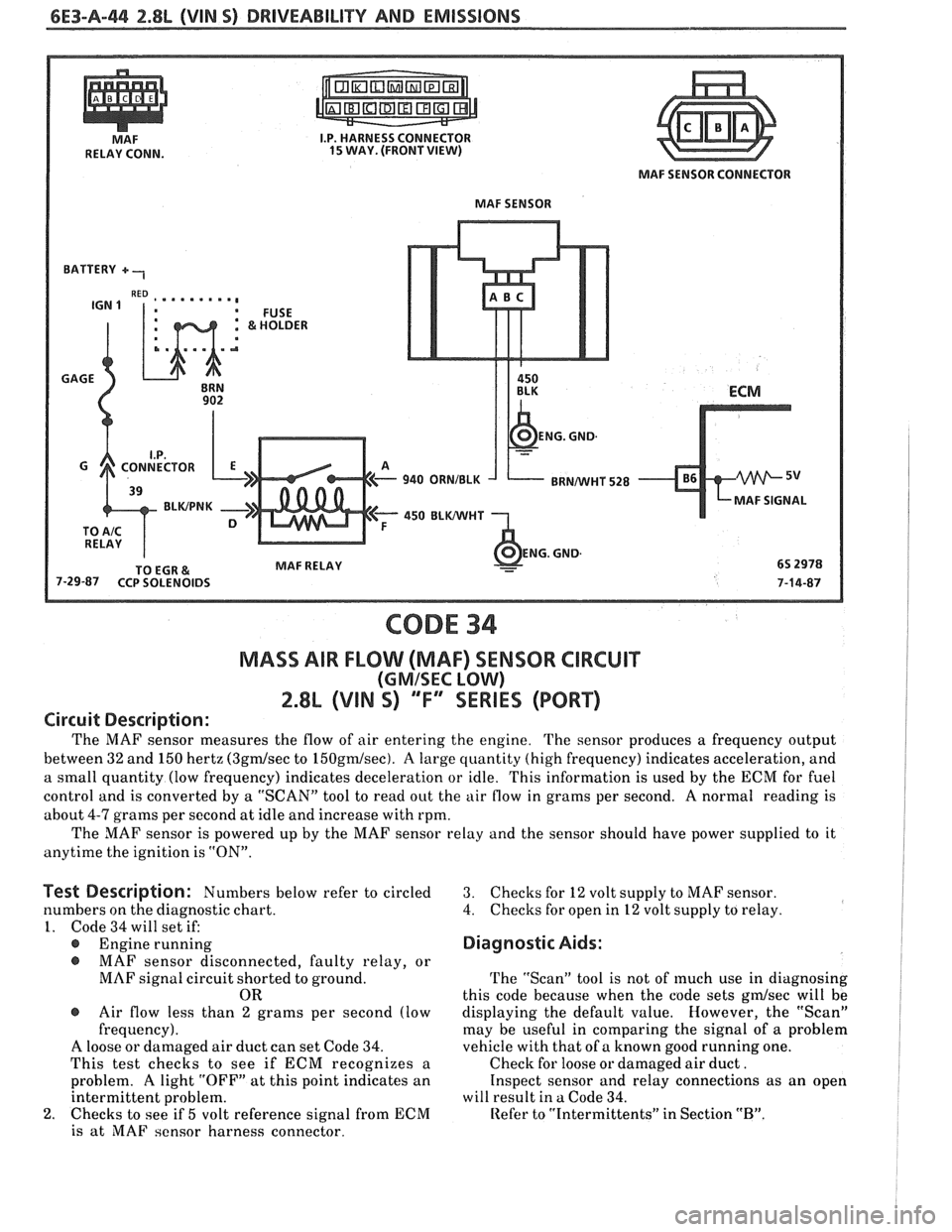
6E3-A-44 2.8L (VIN S) DRIVEABILITY AND EMISSIONS
NlnF RELAY CONN.
BATTERY
+ -,
I.P. HARNESS CONNECTOR IS WAY. (FRONTVIEW)
I.. . . . . . ., 1. EllCE
a
GAGE
902
TO EGR
& MAF RELAY 7-29-87 CCP SOLENOIDS MAF
SENSOR
ENG.
GND.
MAF SENSOR CONNECTOR
ECM
CODE 34
MASS AIR FLOW (MAF) SENSOR CIRCUIT
(GMISEC LOW)
2.8L (VIN 5) "F" SERIES (PORT)
Circuit Description:
The MAF sensor measures the flow of air entering the engine. The sensor produces a frequency output
between 32 and 150 hertz
(3grnfsec to 150gndsec). A large quantity (high frequency) indicates acceleration, and
a small quantity (low frequency) indicates deceleration or idle. This information is used by the ECM for fuel
control and is converted by a "SCAN" tool to read out the air flow in grams per second. A normal reading is
about 4-7 grams per second at idle and increase with rpm.
The MAF sensor is powered up by the MAF sensor relay and the sensor should have power supplied to it
anytime the ignition is "ON".
Test Description: Numbers below refer to circled
numbers on the diagnostic chart.
I. Code 34 will set if:
@ Engine running
@ MAF sensor disconnected, faulty relay, or
MAF signal circuit shorted to ground.
OR
@ Air flow less than 2 grams per second (low
frequency).
A loose or damaged air duct can set Code 34.
This test checks to see if ECM recognizes a
problem.
A light "OFF" at this point indicates an
intermittent problem.
2. Checks to see if 5 volt reference signal from ECM
is at MAF
sensor harness connector.
3. Checks for 12 volt supply to MAF sensor.
4. Checks for open in 12 volt supply to relay.
Diagnostic Aids:
The "Scan" tool is not of much use in diagnosing
this code because when the code sets
gdsec will be
displaying the default value. However, the "Scan"
may be useful in comparing the signal of a problem
vehicle with that of a known good running one.
Check for loose or damaged air duct.
Inspect sensor and relay connections as an open
will result in
a Code 34.
Refer to "Intermittents" in Section "B".